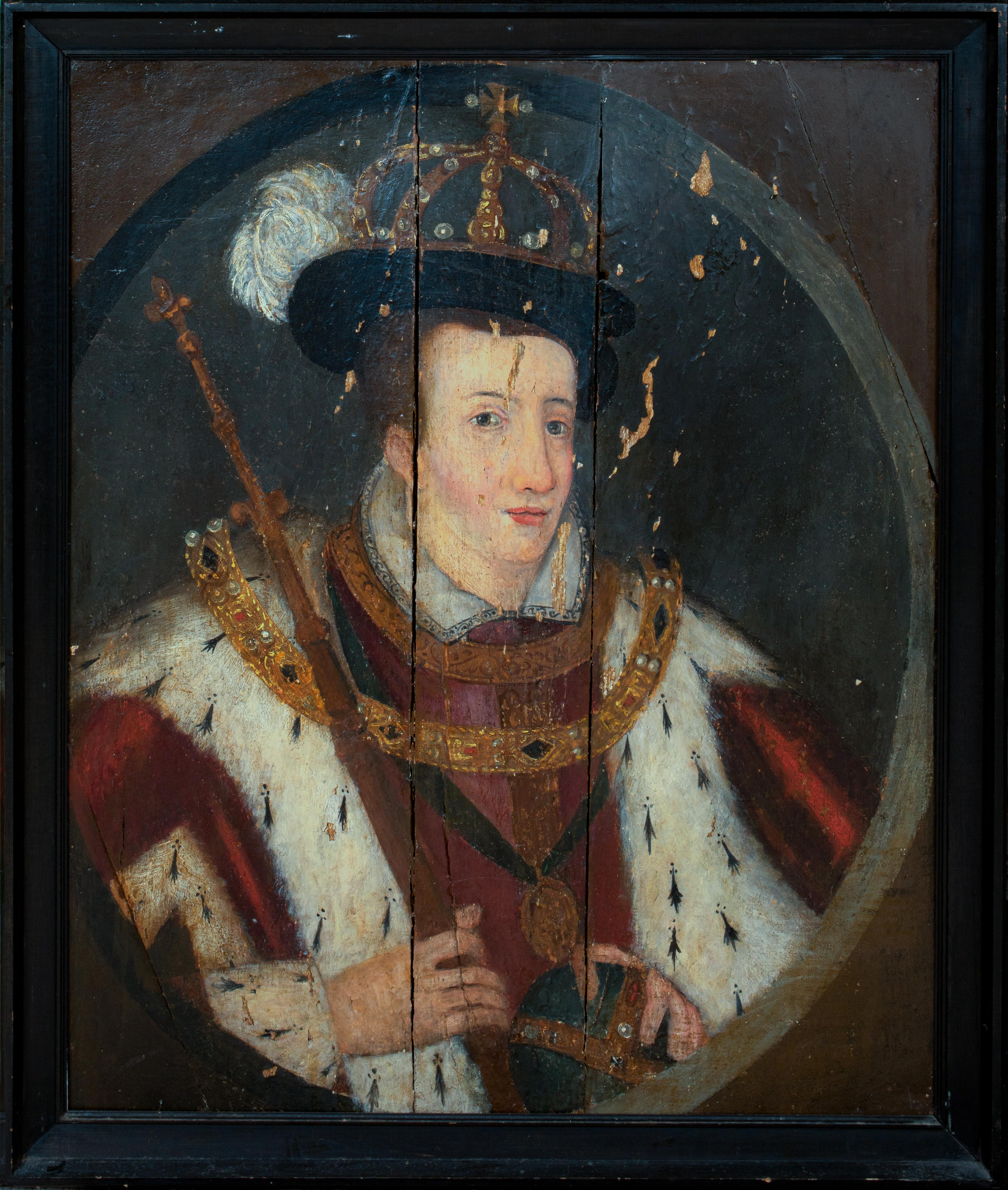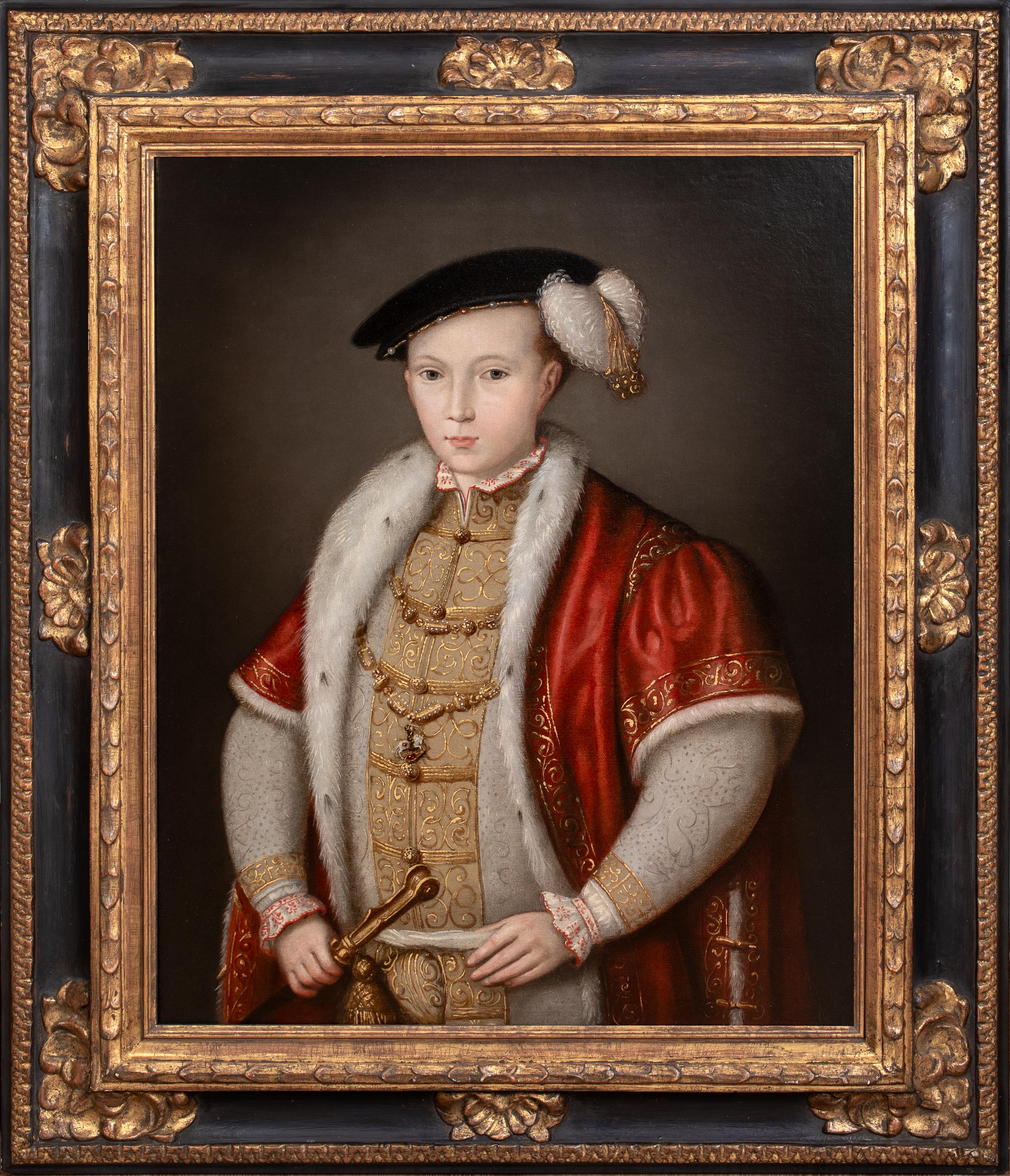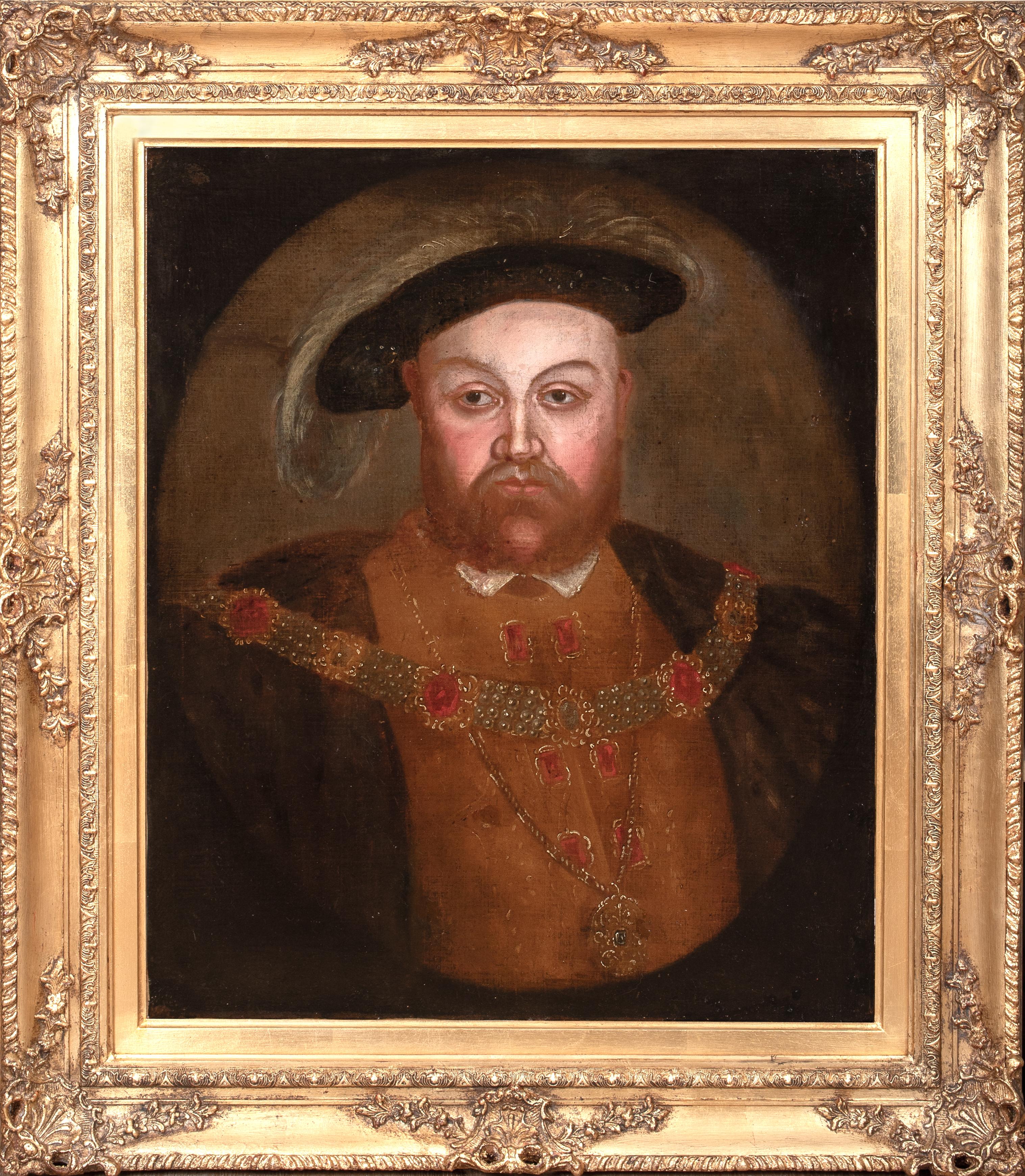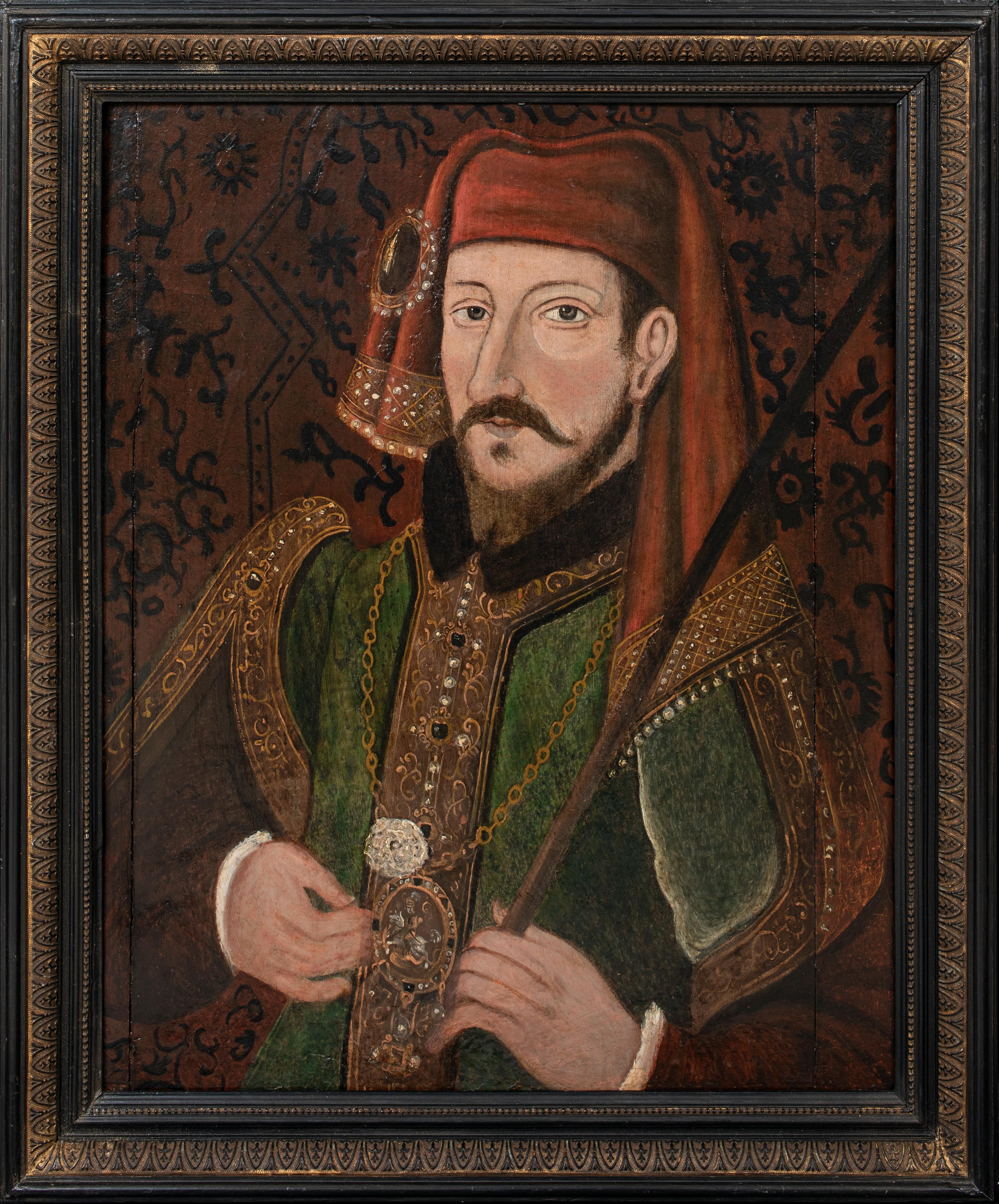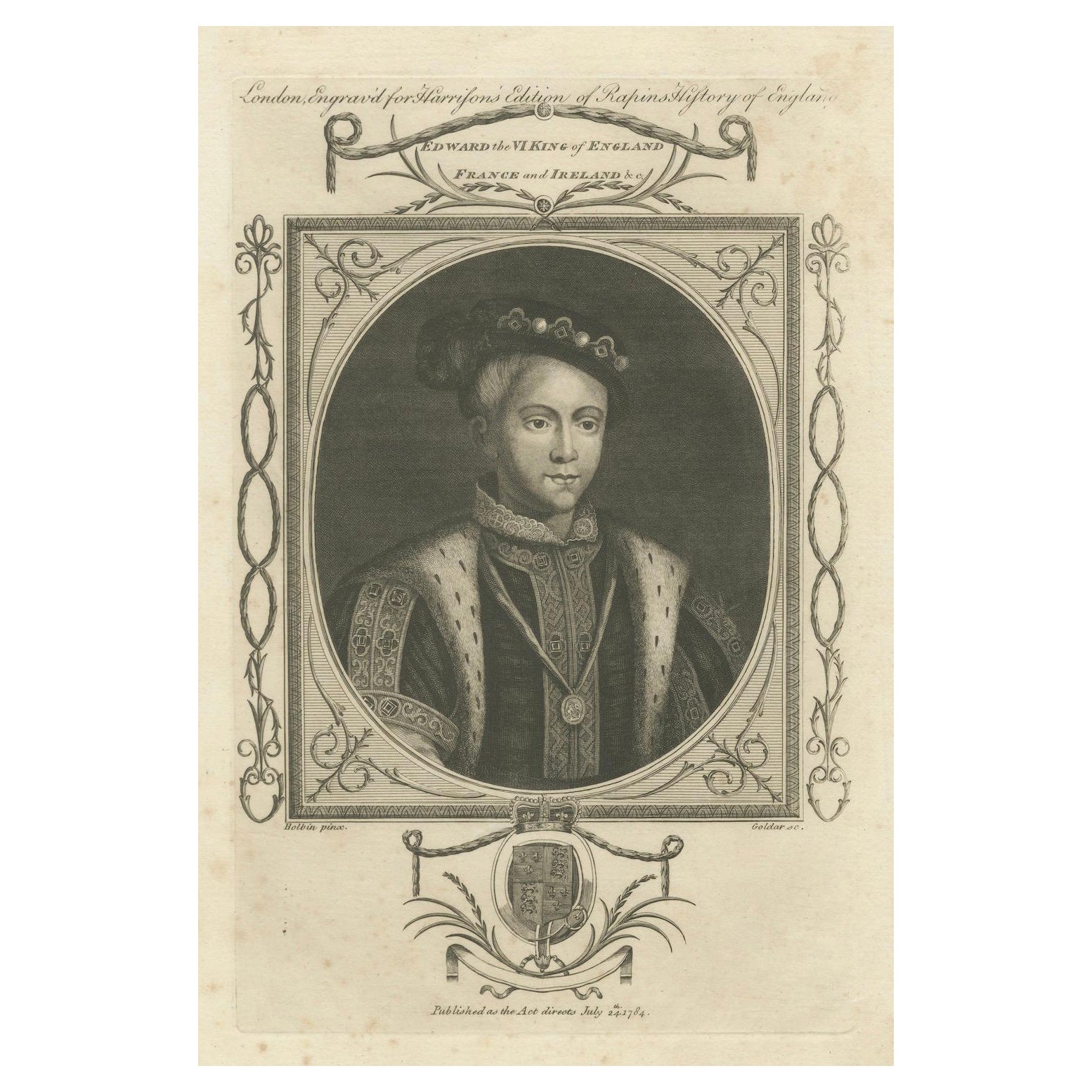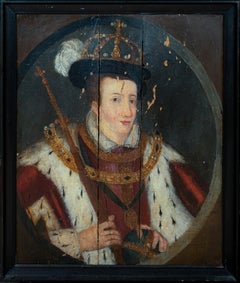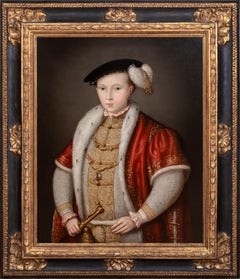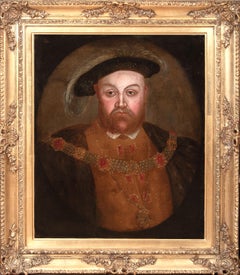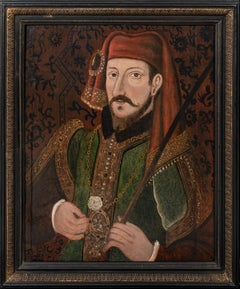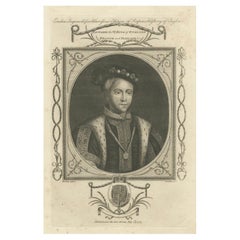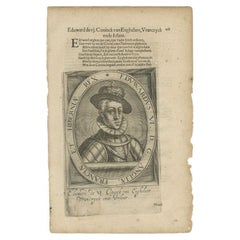Items Similar to Portrait Of King Edward VI (1537-1553) as Prince Of Wales, 16th Century
Want more images or videos?
Request additional images or videos from the seller
1 of 11
UnknownPortrait Of King Edward VI (1537-1553) as Prince Of Wales, 16th Century
$13,692.39
£9,900
€11,698.07
CA$18,924.94
A$21,045.79
CHF 11,046.23
MX$256,643.29
NOK 139,602.40
SEK 130,882.81
DKK 87,312.94
About the Item
Portrait Of King Edward VI (1537-1553) as Prince Of Wales, 16th Century
English School - Oil on panel - circa 1547
Large 16th Century portrait of Edward VI as Prince Of Wales, oil on panel. Early and important portrait of the young monarch, son of Henry VIII and Jane Seymour, in anticipation of the crown holding a flower. One of a pair, the other depicting him as King of England & Ireland. Framed. Some losses and panel bowing. We can quote for full restoration.
Provenance: A private collection, UK
Measurements: 37" x 30" framed approx
- Dimensions:Height: 37 in (93.98 cm)Diameter: 30 in (76.2 cm)
- Medium:
- Period:
- Condition:
- Gallery Location:Blackwater, GB
- Reference Number:Seller: 7832951stDibs: LU1577214025062
About the Seller
4.9
Gold Seller
Premium sellers maintaining a 4.3+ rating and 24-hour response times
Established in 2008
1stDibs seller since 2021
292 sales on 1stDibs
Typical response time: 3 hours
- ShippingRetrieving quote...Shipping from: Blackwater, United Kingdom
- Return Policy
Authenticity Guarantee
In the unlikely event there’s an issue with an item’s authenticity, contact us within 1 year for a full refund. DetailsMoney-Back Guarantee
If your item is not as described, is damaged in transit, or does not arrive, contact us within 7 days for a full refund. Details24-Hour Cancellation
You have a 24-hour grace period in which to reconsider your purchase, with no questions asked.Vetted Professional Sellers
Our world-class sellers must adhere to strict standards for service and quality, maintaining the integrity of our listings.Price-Match Guarantee
If you find that a seller listed the same item for a lower price elsewhere, we’ll match it.Trusted Global Delivery
Our best-in-class carrier network provides specialized shipping options worldwide, including custom delivery.More From This Seller
View AllCoronation Portrait Of King Edward VI (1537-1553) as King Of England & Ireland
Located in Blackwater, GB
Coronation Portrait Of King Edward VI (1537-1553) as King Of England & Ireland, 16th Century
English School - Oil on panel - circa 1547
Large 16th Century Coronation portrait of Edward VI as King Of England & Ireland, oil on panel. Early and important portrait...
Category
16th Century Portrait Paintings
Materials
Oil, Wood Panel
Court Portrait Of King Edward VI (1537-1553) King Of England
Located in Blackwater, GB
Portrait Of King Edward VI (1537-1553) King Of England
after William SCROTS (1510-1553)
Large circa 17th/18th Century portrait of Edward VI, King Of England, oil on canvas. Excellent quality and condition half length portrait of the only surviving son of King Henry VIII and Jane Seymour wearing Prince Of Wale Feathers and the crown upon a pendant. Exceptional quality distinctly similar to the works of court painter William Scrots. Presented in a gilt & ebony frame.
Measurements: 40" x 34" framed approx
Provenance: The estate of Richard Philip...
Category
17th Century Portrait Paintings
Materials
Canvas, Oil
Portrait Of King Henry VIII (1491-1547), 17th Century Royal Court Portrait
Located in Blackwater, GB
Portrait Of King Henry VIII (1491-1547), 17th Century
English School Royal Court Portrait
Large 17th Century English Royal Court Portrait of King Henry VIII Of England, oil on canv...
Category
17th Century Portrait Paintings
Materials
Canvas, Oil
Portrait of Henry IV, King of England (1367-1413), 16th Century
Located in Blackwater, GB
Portrait of Henry IV, King of England (1367-1413), 16th Century
English School Portrait - Early Oil On Panel
Large 16th Century court portrait of Henry IV, King Of England (1367-14...
Category
16th Century Portrait Paintings
Materials
Oil, Wood Panel
Portrait Of Gilbert Talbot 7th Earl of Shrewsbury (1552-1616), 16th Century
Located in Blackwater, GB
Portrait Of Gilbert Talbot 7th Earl of Shrewsbury (1552-1616), 16th Century
Circle of George Gower (c.1540–1596)
Huge 16th Century Portrait Of Gil...
Category
18th Century Portrait Paintings
Materials
Canvas, Oil
Portrait Of A Gentleman, identified as Robert Carr, Earl Of Somerset (1587-1645)
Located in Blackwater, GB
Portrait Of A Gentleman, identified as Robert Carr, Earl Of Somerset (1587-1645), 17th Century
English Court Portrait dated 1625
Large 17th Century English Court Portrait, possibly...
Category
17th Century Portrait Paintings
Materials
Canvas, Oil
You May Also Like
Portrait of King Edward VI, Oil on panel with Gold Leaf, 18th Century English
Located in London, GB
Oil on oak panel
Image size: 25 1/2 x 19 inches (37.5 x 27 inches)
18th Century Auricular gilt frame
Provenance
New York private collection
This portrait of the King Edward VI depicts the boy-king standing in a black and gold embroidered doublet, wearing a jewelled cap. King Edward holds a staff with a globus cruciger set on the table beside him. No expense has been spared in the making of this piece, with gold leaf being applied in many areas to give the effect of the costume's gold embroidery, chain of office and other metal accessories.
As the precious male heir to the Tudor dynasty...
Category
Early 18th Century English School Portrait Paintings
Materials
Gold Leaf
1784 Engraved Portrait of Edward VI - Young English Monarch
Located in Langweer, NL
An original antique engraved portrait from Harrington's edition of "Rapin's History of England."
The text identifies the subject as Edward the VI, King of England, France, and Ireland. The engraving is again by Goldar, indicating John Goldar's work, and it was published as the act directs on July 22nd, 1784.
Edward VI was the son of Henry VIII and his third wife, Jane Seymour. Born on October 12...
Category
Antique 1780s Prints
Materials
Paper
Antique Portrait of Edward VI of England by Janszoon, 1615
Located in Langweer, NL
Antique portrait titled 'Iacobus VI (..)'. Portrait of Edward VI of England. This print originates from 'Tooneel der keyseren ende coningen van christenryck ...
Category
Antique 17th Century Prints
Materials
Paper
$276 Sale Price
20% Off
Portrait of William Herbert, 3rd Earl of Pembroke, Early 17th Century Portrait
Located in London, GB
English School, (circa 1600)
Portrait of William Herbert, 3rd Earl of Pembroke
Oil on panel, oval
Image size: 29¼ x 23⅞ inches
Painted wooden frame
Provenance:
176, Collection of Francis Greville, 1st Earl of Warwick.
The Trustees of the Lord Brooks’ Settlement, (removed from Warwick Castle).
Sotheby’s, London, 22nd March 1968, lot 81.
Painted onto wooden panel, this portrait shows a dark haired gentleman in profile sporting an open white shirt. On top of this garments is a richly detailed black cloak, decorated with gold thread and lined with a sumptuous crimson lining. With the red silk inside it’s all very expensive and would fall under sumptuary laws – so this is a nobleman of high degree.
It’s melancholic air conforms to the contemporary popularity of this very human condition, evident in fashionable poetry and music of the period. In comparison to our own modern prejudices, melancholy was associated with creativity in this period.
This portrait appeared in the earliest described list of pictures of Warwick castle dating to 1762. Compiled by collector and antiquary Sir William Musgrave ‘taken from the information of Lord & Lady Warwick’ (Add. MSS, 5726 fol. 3) is described;
‘8. Earl of Essex – an original by Zuccharo – seen in profile with black hair. Holding a black robe across his breast with his right hand.’
As tempting as it is to imagine that this is a portrait of Robert Devereux, the 2nd Earl Essex, we might take this with a pinch of salt. Its identification with this romantic and fatal Elizabethan might well have been an attempt to add romance to Warwick Castle’s walls. It doesn’t correspond all that well with Essex’s portraits around 1600 after his return from Cadiz. Notably, this picture was presumably hung not too far away from the castle’s two portraits of Queen Elizabeth I. The first, and undoubtedly the best, being the exquisite coronation portrait that was sold by Lord Brooke in the late 1970s and now hangs in the National Portrait Gallery. The second, described as being ‘a copy from the original at Ld Hydes’, has yet to resurface.
The portrait eventually ended up being hung in the State Bedroom of Warwick Castle.
Archival documents present one other interesting candidate. The Greville family’s earliest inventory of paintings, made in 1630 at their home Brooke House in Holborn, London, describes five portraits of identified figures. All five belonged to the courtier, politician and poet Sir Fulke Greville (1554-1628), 1st Baron Brooke, and were hung in the ‘Gallerie’ of Brooke House behind yellow curtains. One of them was described as being of ‘Lord of Pembrooke’, which is likely to have been William Herbert (1580-1630), 3rd Earl of Pembroke. William was the eldest son of Greville’s best friend’s sister Mary Sidney, and was brought up in the particularly literary and poetically orientated household which his mother had supported. Notably, the 3rd Earl was one of the figures that Shakespeare’s first folio was dedicated to in 1623.
The melancholic air to the portrait corresponds to William’s own pretensions as a learned and poetic figure. The richness of the robe in the painting, sporting golden thread and a spotted black fabric, is indicative of wealth beyond that of a simple poet or actor. The portrait’s dating to around the year 1600 might have coincided with William’s father death and his own rise to the Pembroke Earldom. This period of his life too was imbued with personal sadness, as an illicit affair with a Mary Fitton had resulted in a pregnancy and eventual banishment by Elizabeth I to Wilton after a short spell in Fleet Prison. His illegitimate son died shortly after being born. Despite being a close follower of the Earl of Essex, William had side-stepped supporting Devereux in the fatal uprising against the Queen and eventually regained favour at the court of the next monarch James I.
His linen shirt is edged with a delicate border of lace and his black cloak is lined on the inside with sumptuous scarlet and richly decorated on the outside with gold braid and a pattern of embroidered black spots.
Despite the richness of his clothes, William Herbert has been presented in a dishevelled state of semi-undress, his shirt unlaced far down his chest with the ties lying limply over his hand, indicating that he is in a state of distracted detachment. It has been suggested that the fashion for melancholy was rooted in an increase in self-consciousness and introspective reflection during the late 16th and early 17th centuries.
In contemporary literature melancholy was said to be caused by a plenitude of the melancholy humor, one of the four vital humors, which were thought to regulate the functions of the body. An abundance of the melancholia humor was associated with a heightened creativity and intellectual ability and hence melancholy was linked to the notion of genius, as reflected in the work of the Oxford scholar Robert Burton, who in his work ‘The Anatomy of Melancholy’, described the Malcontent as ‘of all others [the]… most witty, [who] causeth many times divine ravishment, and a kind of enthusiamus… which stirreth them up to be excellent Philosophers, Poets and Prophets.’ (R. Burton, The Anatomy of Melancholy, London, 1621 in R. Strong, ‘Elizabethan Malady: Melancholy in Elizabethan and Jacobean Portraits’, Apollo, LXXIX, 1964).
Melancholy was viewed as a highly fashionable affliction under Elizabeth I, and her successor James I, and a dejected demeanour was adopted by wealthy young men, often presenting themselves as scholars or despondent lovers, as reflected in the portraiture and literature from this period. Although the sitter in this portrait is, as yet, unidentified, it seems probable that he was a nobleman with literary or artistic ambitions, following in the same vain as such famous figures as the aristocratic poet and dramatist, Edward de Vere...
Category
Early 17th Century Old Masters Portrait Paintings
Materials
Oil, Wood Panel
1797 Engraved Portrait of Young King Edward VI - Reformation Leader
Located in Langweer, NL
An engraved portrait of Edward VI, who was King of England and Ireland from 1547 until his death in 1553.
Edward was the son of Henry VIII and his third wife, Jane Seymour, and he ...
Category
Antique 1780s English Prints
Materials
Paper
Portrait King Henry 8th VIII Antique English Painting Famous Monarch
Located in Cirencester, Gloucestershire
King Henry VIII
English artist, circa 1840's
oil on paper laid on board, framed
framed: 10.5 x 10inches
board: 8 x 7.5 inches
inscribed verso
provenance: private collection, UK
cond...
Category
Early 19th Century English School Portrait Paintings
Materials
Oil
More Ways To Browse
Prince Of Wales
King Edward
16th Century England
Henry Viii
Seymour Antique
Henry Vi
Edward Vi
King Edward Viii
Jane Seymour
18th Century Military Portrait
18th Century Spanish Portrait
British Military Portrait Painting
Charles Lutz Brillo
Sir Joshua Reynolds
Antique Oil Portrait Child
Charles Lutz Warhol Denied
Cavalier Portrait
Jackie Kennedy Painting
